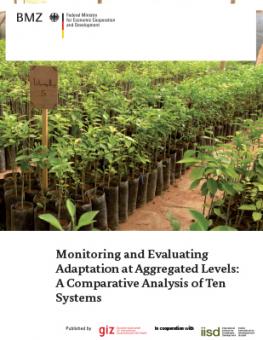
Monitoring and Evaluating Adaptation at Aggregated Levels: A Comparative Analysis of Ten Systems
The paper Monitoring and Evaluating Adaptation at Aggregated Levels: A Comparative Analysis of Ten Systems provides an introduction to different approaches and experiences in designing and implementing (piloting) M&E systems for adaptation at the portfolio, national, regional and international levels.
Drawing upon information gathered through a combination of document analysis and stakeholder interviews, it compares ten aggregate M&E systems according to their context, processes and content.
The analysis provides insights into challenges and enabling factors for the design and implementation of M&E adaptation systems at higher, aggregated levels. Challenges identified include the conceptual ambiguity of what constitutes successful adaptation; coordination and harmonization across sectors, scales and partners; resource and capacity constraints; and identification and access to data and information.
Enabling factors for designing, establishing and, where relevant, implementing M&E systems for adaptation were also identified, namely: political will and leadership; multi-stakeholder participation; and alignment and/or integration of an evolving M&E system for adaptation into/with existing M&E structures, which can save resources in the long run. The report concludes by providing recommendations regarding ways in which to strength the development of aggregated level M&E adaptation systems.
Monitoring and Evaluating Adaptation at Aggregated Levels: A Comparative Analysis of Ten Systems was written by Anne Hammill and Julie Dekens of IISD for Deutsche Gesellschaft für Internationale Zusammenarbeit (GIZ), acting on behalf of Germany’s Federal Ministry for Economic Cooperation and Development (BMZ).
Participating experts
You might also be interested in
Developing national adaptation monitoring and evaluation systems: A guidebook
This guidebook is intended for decision makers and technical advisors involved in the development of national monitoring and evaluation (M&E) systems for adaptation, particularly in developing and middle-income countries.
COP 29 Outcome Moves Needle on Finance
In the last hours of negotiations, concerted pressure from the most vulnerable developing countries resulted in an improved outcome on the finance target, with a decision to set a goal of at least USD 300 billion per year by 2035 for developing countries to advance their climate action.
What Is the NAP Assessment at COP 29, and Why Does It Matter?
At the 29th UN Climate Change Conference (COP 29) in Baku, countries will assess their progress in formulating and implementing their National Adaptation Plans. IISD’s adaptation experts Orville Grey and Jeffrey Qi explain what that means, and what’s at stake.
IISD Annual Report 2023–2024
While IISD's reputation as a convenor, a trusted thought leader, and a go-to source on key issues within the sustainable development field is stronger than ever, the work happening outside the spotlight is just as valuable.